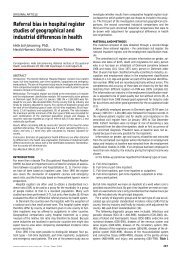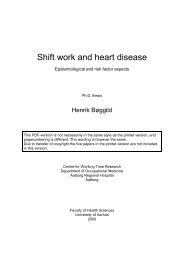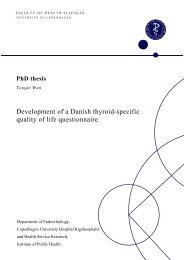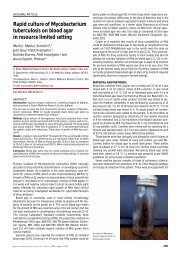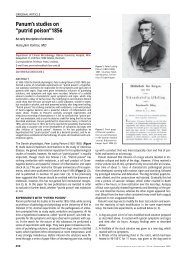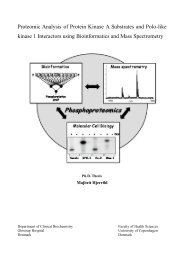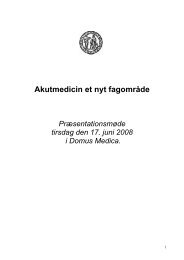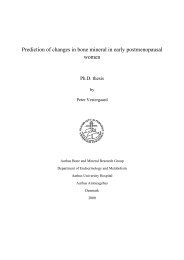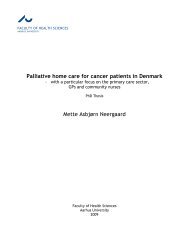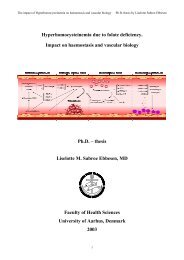Acute stroke â a dynamic process - Danish Medical Bulletin
Acute stroke â a dynamic process - Danish Medical Bulletin
Acute stroke â a dynamic process - Danish Medical Bulletin
Create successful ePaper yourself
Turn your PDF publications into a flip-book with our unique Google optimized e-Paper software.
variables include body temperature, blood pressure, blood glucose,<br />
C-reactive protein, white blood cell counts, corticosteroids, cardiac<br />
enzymes, and ECG. These relate to outcome, and causality has been<br />
assumed for some of these variables, based on observational findings<br />
and animal models.<br />
Most observational studies in acute <strong>stroke</strong> are based on patients<br />
admitted to hospital with some delay from <strong>stroke</strong> onset, and in a<br />
number of studies the latency from <strong>stroke</strong> onset to admission was<br />
not well defined.<br />
These variables may be more or less static in acute <strong>stroke</strong> and<br />
changes within the first hours and days after symptom onset would<br />
in that case be negligible. This hypothesis has, however not yet been<br />
tested.<br />
Another possibility remains that these changes evolve in the first<br />
hours after <strong>stroke</strong> onset as a result of the <strong>stroke</strong> lesion and possibly<br />
contribute to secondary brain damage.<br />
The aim of the studies on which this thesis was based was to include<br />
this time factor in the analyses by studying a <strong>stroke</strong> population<br />
that was admitted to hospital within six hours of <strong>stroke</strong> onset, by use<br />
of serial measurements within the first hours, and by including the<br />
time factor in the analyses. We further looked into the interplay of<br />
heart and brain as well as the stress response in order to investigate<br />
their possible impact in the first hours after <strong>stroke</strong> onset.<br />
We found that <strong>stroke</strong> severity determines an increase in body<br />
temperature, C-reactive protein, and white blood cell count in the<br />
first hours after <strong>stroke</strong>. The blood pressure course related to the time<br />
of admission and a steep decrease was observed in mild to moderate<br />
<strong>stroke</strong>. Heart rate decreased in patients with mild to moderate<br />
<strong>stroke</strong>, but remained high in patients with severe <strong>stroke</strong> and predicted<br />
outcome. Blood glucose increased and the size of the increase<br />
related to <strong>stroke</strong> severity. The cortisol response related to <strong>stroke</strong> severity,<br />
and predicted outcome independently, and related to blood<br />
glucose, heart rate, a number of ECG-abnormalities, and to insular<br />
damage. ECG-abnormalities relate to insular damage, especially<br />
damage to the right insula, and may predict prognosis. Damage to<br />
the right insula predicts mortality. Troponin I predicted outcome.<br />
We documented that acute <strong>stroke</strong> is a <strong>dynamic</strong> <strong>process</strong> and that<br />
<strong>stroke</strong> severity is a determinant in the changes of physiological parameters.<br />
The stress response as well as cardiac changes may contribute<br />
further to poor prognosis especially in severe <strong>stroke</strong>. Damage<br />
to the right insula may have a key role for the stress response and the<br />
cardiac changes after <strong>stroke</strong>.<br />
ABBREVIATIONS<br />
ACI <strong>Acute</strong> cerebral infarction<br />
ACTH Adrenocorticotropic hormone<br />
App. approximately<br />
CI Confidence intervals<br />
CRP C-reactive protein<br />
CSF Cerebrospinal fluid<br />
CT Computer-assisted tomography<br />
cTnI Cardiac troponin I<br />
cTnT Cardiac troponin T<br />
DBP Diastolic blood pressure<br />
ECG Electrocardiogram<br />
ECG Electrocardiography<br />
HR Heart rate<br />
ICH Intracerebral haemorrhage<br />
IL-1β Interleukine 1β<br />
IL-10 Interleukine 10<br />
IL-1RA Interleukine 1 receptor antagonist<br />
IL-6 Interleukin-6<br />
MAP Mean arterial pressure (MAP = DBP + 1/3 (SBP – DBP)<br />
MCA Middle cerebral artery<br />
MI Myocardial infarction<br />
mRS modified Rankin Scale<br />
NIHSS National Institute of Health Stroke Scale<br />
OCSP Oxfordshire Community Stroke Project Classification<br />
OR Odds ratio<br />
PAI-1 Plasminogen activator inhibitor-1<br />
QTc Corrected Q-T interval<br />
SBP Systolic blood pressure<br />
SSS Scandinavian Stroke Scale<br />
TCD Transcranial doppler<br />
TIA Transient ischaemic attack<br />
TNF-α Tumor necrosis factor-α<br />
TNF-R1 Tumor necrosis factor receptor 1<br />
TNF-R1 Tumor necrosis factor receptor 2<br />
WBC White Blood Cell<br />
ORIGINAL PAPERS:<br />
I. Boysen G, Christensen H. Stroke severity determines body<br />
temperature in acute <strong>stroke</strong>. Stroke. 2001;32:413-417<br />
II. Christensen H, Meden P, Overgaard K, Boysen G. The course<br />
of blood pressure in acute <strong>stroke</strong> is related to the severity of the<br />
neurological deficits. Acta Scand Neurol. 2002;106:142-147<br />
III. Christensen H, Boysen G. Eur Blood glucose increases early after<br />
<strong>stroke</strong> onset: a study on serial measurements of blood glucose<br />
in acute <strong>stroke</strong>. J Neurol. 2002;9:297-301<br />
IV.<br />
Christensen H, Boysen G, Johannesen HH. Serum-cortisol reflects<br />
severity and mortality in acute <strong>stroke</strong>. J Neurol Sci.<br />
2004;217:175-180<br />
V. Christensen H, Christensen AF, Boysen G. Abnormalities on<br />
ECG and telemetry predict <strong>stroke</strong> outcome at 3 months. J<br />
Neurol Sci. 2005; 234:99-103<br />
VI. Christensen H, Johannesen HH, Christensen AF, Bendtzen K,<br />
Boysen G. Serum cardiac troponin I in acute <strong>stroke</strong> is related<br />
to serum cortisol and TNF-a. Cerebrovasc Dis. 2004;18:194-<br />
199.<br />
VII. Christensen H, Boysen G, Christensen AF, Johannesen HH.<br />
Insular lesions, ECG-abnormalities, and outcome in acute<br />
<strong>stroke</strong>. J Neurol Neurosurg Psychiatry. 2005;76:269-271<br />
VIII. Christensen H, Boysen G. C-reactive protein and white blood<br />
cell count increases in the first 24 hours after acute <strong>stroke</strong>. Cerebrovasc<br />
Dis. 2004;76:214-219<br />
REFERENCES<br />
1. Hajat C, Hajat S, Sharma P. Effects of post-<strong>stroke</strong> pyrexia on <strong>stroke</strong> outcome.<br />
A meta-analysis of studies in patients. Stroke 2000;31(2):410-4.<br />
2. Christensen H, Boysen G. Acceptable agreement between tympanic and<br />
rectal temperature in acute <strong>stroke</strong> patients. IJCP 2002;56:82-4.<br />
3. Castillo J, Davalos A, Marrugat J, Noya M. Timing for fever-related<br />
brain damage in acute ischemic <strong>stroke</strong>. Stroke 1998;29(12):2455-60.<br />
4. Castillo J, Martinez F, Laira R, Prieto JM, Lema M, Noya M. Mortality<br />
and morbidity of acute cerebral infarction related to temperature and<br />
basal analytic parameters. Cerebrovasc Dis 1994;4:66-71.<br />
5. Terént A, Andersson B. The prognosis for patients with cerebrovascular<br />
<strong>stroke</strong> and transient ischemic attacs. Ups Med J 1981;86:63-74.<br />
6. Hindfelt B. The prognostic significance of subfebrility and fever in ischaemic<br />
cerebral infarction. Acta Neurol Scand 1976;53:72-9.<br />
7. Kammersgaard LP, Jørgensen HS, Rungby JA, Reith J, Nakayama H, Weber<br />
UJ et al. Admission body temperature predicts long-term mortality<br />
after acute <strong>stroke</strong>. The Copenhagen Stroke Study. Stroke 2002;33(1759):<br />
1762.<br />
8. Suzuki S, Kelly RE, Dandapani BK, Reyes-Iglesias Y, Dietrich WD, Duncan<br />
RC. <strong>Acute</strong> leukocyte and temperature response in hypertensive intracerebral<br />
hemorrhage. Stroke 1995;26:1020-3.<br />
9. Azzimondi G, Bassein L, Nonino F, Fiorani L, Vignatelli L, Re G, et al.<br />
Fever in acute <strong>stroke</strong> worsen prognosis. Stroke 1995;26:2040-3.<br />
10. Schwartz S, Häfner K, Aschoff A, Schwab S. Incidence and prognostic<br />
significance of fever following intracerebral hemorrhage. Neurology<br />
2000;54:354-61.<br />
11. Reith J, Jørgensen HS, Pedersen PM, Nakayama H, Raaschou HO,<br />
Jeppesen P, et al. Body temperature in acute <strong>stroke</strong>:relation to <strong>stroke</strong> severity,<br />
infarct size, mortality and outcome. Lancet 1996;347:422-5.<br />
12. MacWalter R, McMahon A, Fraser H, Bruce V, Hendrick S. Does body<br />
temperature on admission predict long-term outcome after an acute<br />
<strong>stroke</strong>? Cerebrovasc Dis 1998;8 (suppl 4):abstract 36.<br />
13. Wang Y, Lim LL-Y, Levi C, Heller RF, Fisher J, Maths B. Influence of admission<br />
body temperature on <strong>stroke</strong> mortality. Stroke 2000;31:404-9.<br />
DANISH MEDICAL BULLETIN VOL. 54 NO. 3/AUGUST 2007 221



